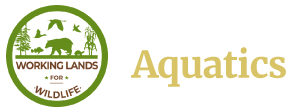Introducing the Aquatic Resource Compass
The Aquatic Resource Compass: A New Tool to Guide Aquatic Conservation
by: Brian Rhodes
Conservation work is more effective when backed by the right tools and information. That’s why we’re excited to unveil the Aquatic Resource Compass—a comprehensive new resource designed to support landowners, conservation planners, and NRCS partners as they navigate the challenges of aquatic resource management.
This powerful tool simplifies access to essential information on NRCS Conservation Practices (CPs), funding opportunities, and decision-support tools. It also helps tailor conservation efforts to meet specific goals for land and aquatic ecosystems.
What is the Aquatic Resource Compass?
The Aquatic Resource Compass is a centralized, easy-to-navigate dashboard that empowers users to make informed decisions about conservation strategies. Whether you’re working to improve farm productivity, restore a stream, enhance water quality, or protect at-risk species, this tool connects you to the resources that can make those efforts successful.
The Aquatic Resource Compass streamlines the conservation process by consolidating information about NRCS Conservation Practices, available funding, and helpful planning tools. It’s designed to remove complexity and make it easier for landowners and professionals to effectively address working lands and environmental challenges.
How to Navigate the Aquatic Resource Compass
The Aquatic Resource Compass allows you to search for conservation practices based on your specific needs. You can explore options by:
-
Benefit: Focus on the desired outcomes, such as improved water quality, better livestock health and production, enhanced aquatic habitats, or better species protection.
-
Threat/Concern: Search by the issues impacting your land and aquatic resources, from sedimentation to nutrient pollution or habitat degradation.
-
Conservation Practice (CP): If you’re familiar with NRCS CPs, you can go directly to the practices that align with your goals. Each CP is thoroughly detailed, with information on how to implement them and where they’re most effective.
The Aquatic Resource Compass also allows you to explore funding information. It provides a directory of funding programs organized by agencies such as NRCS and FSA. It explains the difference between the two agencies.
The Compass provides information about other decision-support tools and resources that may be relevant to your conservation work. Drop-down menus for threat, species, or area needs can further sort these tools.
A Closer Look: Improving Water Quality with the Aquatic Resource Compass
Imagine you manage land where sediment runoff impacts your land and a local stream. After rainstorms, the water becomes cloudy, affecting the health of aquatic life downstream. This topsoil loss endangers your land’s productivity and soil health.
-
Search by Benefit
-
You can begin by selecting “Explore by Benefit.” Select “Producer Benefits.” Since sediment runoff is caused by erosion, select “Reduced Erosion.” The Aquatic Resource Compass lists conservation practices related to this benefit, such as riparian buffers, cover crops, and critical planting.
-
Alternatively, you can select “Explore by Benefit,” then “Wildlife Benefits,” and “Water Quality. Again, the Compass will list Conservation Practices for this benefit, such as CP 580 - Streambank and Shoreline Protection.
-
Narrow by Threat
-
You may refine your search by threat. Select “Explore by Threats + Resource Concerns,” select “Water Threats,” then “Sediment Transferred to Surface Water.” The Compass recommends CP 391 - Riparian Forest buffer will have Substantial Improvement while CP 329 - Residue and Tillage Mgmt (No-Till), CP 342 - Critical Area Planting, and CP 327 - Conservation Cover will provide Moderate to Substantial Improvement.
-
Learn About the Practice
-
The Aquatic Resource Compass provides detailed information on each practice. Since CP 391—Riparian Forest buffer will Substantially improve our sedimentation threat, click on the CP’s link. The Compass provides a definition, benefits, and other resource concerns this CP will address, as well as resources from the NRCS, such as the national conservation practice standard document.
Why the Aquatic Resource Compass Matters
The Aquatic Resource Compass is designed to simplify aquatic conservation planning by bringing together all the critical information you need in one place. With access to targeted conservation practices, funding opportunities, and planning tools, you’ll be equipped to address your land’s specific needs while contributing to the health of larger ecosystems.
Start using the Aquatic Resource Compass today and take the next step toward creating healthier, more sustainable working lands.























